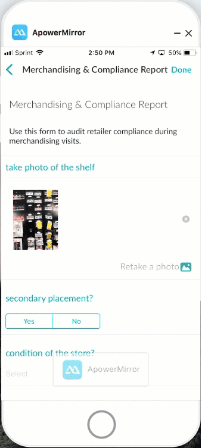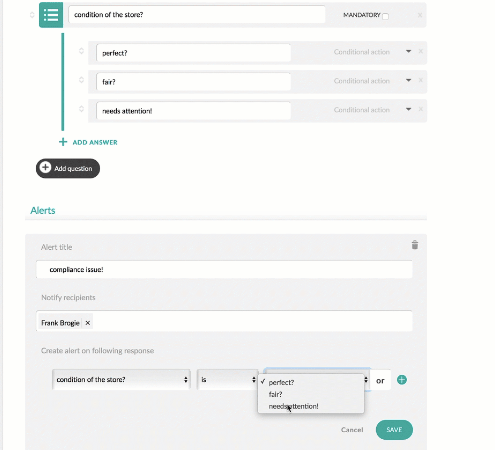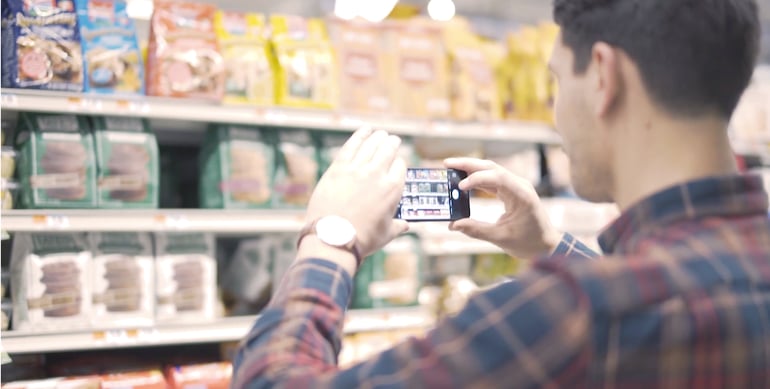To grow your brand, you’ve done more hands-on work than you probably care to remember. You’ve spent countless hours on your feet at tastings and events, and countless more in the car driving to meet with store managers and buyers. All of this you’ve done to increase your product’s presence in stores and availability for your customers. This is vital to the growth of your brand, but how much do you actually know about what happens to your products on the shelf after you’ve left?
That’s where your field team comes in. Having reps hit your accounts and retail locations to follow up with customers and check in on progress is key, but their efforts are limited by how well they can relay back the problems and opportunities they see in the store. On top of that, you don’t have nearly enough time to read through and analyze a separate email write-up for each visit they make.
Luckily, there is a better way to get and share key data from the store in real-time. By using customized mobile forms, you can trade the burden of email write-ups with data that’s easy to report and organize. In this post, we’ll walk you through three ways to use mobile forms to get the best data from your retail accounts:
Hone in on Specific Store-Level Details
Think about the frustration of reading through report after report from your reps, only to find that you still don’t fully understand what’s going on in the store. The most irritating problem with email reports is that they require you to read through lots of text and pick out key information.
With mobile forms, you can customize the information that you want your reps to look for, and how you want it to be recorded. Maybe you need to know how many facings there are within the store, what promotions are currently running, or just need a detailed idea of what each facing looks like. Forms allow you to get this information easily, and give you a better way to see into the store in real time.
7 Sample Store-Level Details to Track in Mobile Forms
So where should you start? Here are seven store-level details brands can track to get a clear sense of how they’re being presented and sold at all of their accounts. To see how to set up and track these retail KPIs, check out our 10-minute webinar here!
- Where are we sold in the store?
- How many facings do we have?
- Do we have a secondary placement?
- What price are we being sold at?
- Are we on promotion?
- What competitors are being sold nearby?
- Are our competitors on promotion?
Here’s what a few of those questions might look like in a simple mobile form your reps can fill out at the store.
.png?width=773&name=Screen%20Shot%202018-05-22%20at%2012.46.11%20PM-min%20(1).png)
Here you can see just how easy forms make it for your reps to prioritize your key metrics. Plus, the data is clearly organized, so you can pull insights in a fraction of the time it would take to go through an email write-up.
Prioritize Reporting
Beyond improving day-to-day organization, mobile forms give brands the opportunity to slice and dice their retail data creatively, making it easier to uncover opportunities for improvement. For some teams, it’s useful to see retail data sorted by chain or store type -- others prefer to analyze by sales rep to see who has been the most effective in growing their accounts. No matter how you prefer to look at it, data that’s collected and organized in forms is super easy to manipulate and report on.
Here are a few ways you might want to sort your store data to identify opportunities for growth at retail:
By Rep
You’ve got many reps in the field, and keeping track of the data that each one reports or which accounts they’re in charge of isn’t worth the headache. Organizing data by rep allows you to compare performance across your team, or simply to organize which rep is responsible for communicating with each account.
By Store
Each of your reps is responsible for more than one store, and asking them to remember the little details of each store between visits is near impossible. Suppose there is a long gap between visits to each retail account, or that a new rep is visiting that account. By organizing your data by store, your reps can now remind themselves about the last visit and which specific details to look for once they enter each store.
By Activity Type
Teams that wear a lot of hats might want to create unique forms for each activity they do in the store (merchandising, new orders, events, etc.) Some are simply to keep tabs and measure performance, but others require immediate action, so it’s helpful to sort between the details of each activity. For example, an “out of stock” form might indicate which of your accounts or products need a new shipment in order to meet demand. Next time you’re about to ship your product to retailers, you can simply pull up all of your out of stock forms to easily see all of the accounts or products that need replenishment.

Just like that, you no longer have to struggle with misplaced or hard to find data. Filtering your forms makes reporting easy, so you can look at specific information whenever you want in just a few clicks.
Set Up Alerts to Solve Problems in Real Time
How many times have you read through one of your reps’ store visit reports and said to yourself, “If only I knew that when they were still at the store!” By using forms that update in real time, you can address any questions or concerns that arise while your reps are still in the store.
Getting real-time notifications can save headaches down the road. Here are just a few ways how:
Misplaced Displays
Say that one of your reps notes that one of your displays is in the wrong location. You now can be notified about this as soon as your rep records it, and can ask for additional information such as where the display is supposed to be located compared to where it actually is. You can ask for pictures of the display, and can work with your rep and the store manager to right the issue while they are still in the store.
Out of stocks
Going back to our out of stock example, you could set your form to instantly notify a manager whenever a rep records that an account needs more of a certain product. You can then work with your rep and any distributors to replenish the stock as soon as possible.

By using real-time updates strategically, you and your team can be clearer and more proactive in the transfer of data between reps and managers, and communicate about issues or questions as they occur.
These three tips will not only help your team to gather better data from your retail accounts, but to use it in more effective ways to help your brand’s growth. Try using these suggestions about mobile forms with respect to your team’s needs, and see how your data improves.


.png?width=773&name=Screen%20Shot%202018-05-22%20at%2012.46.11%20PM-min%20(1).png)




